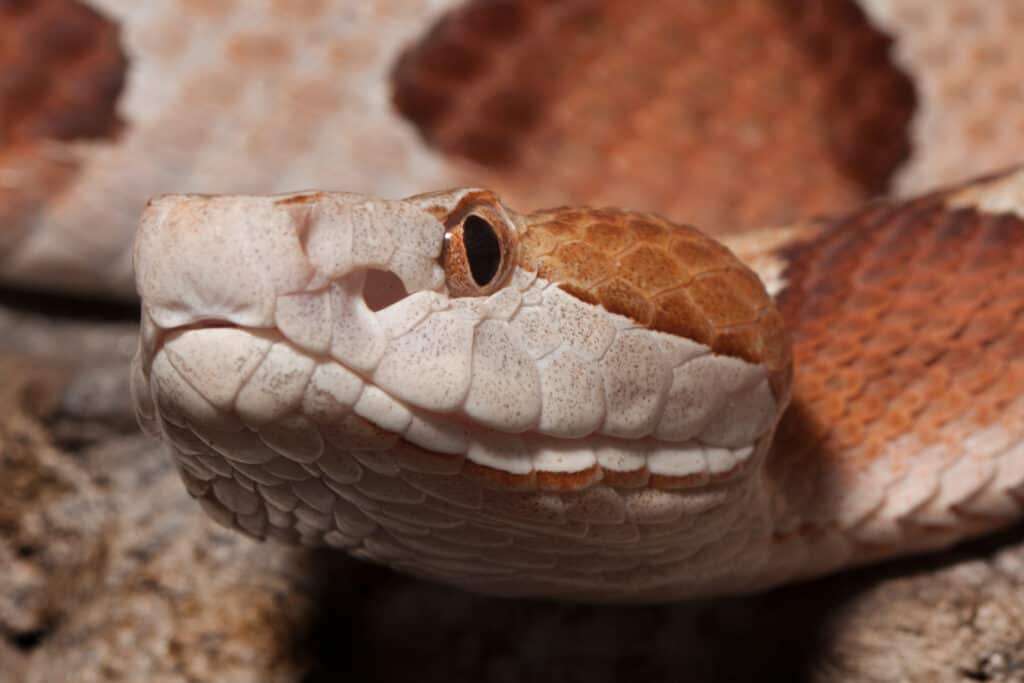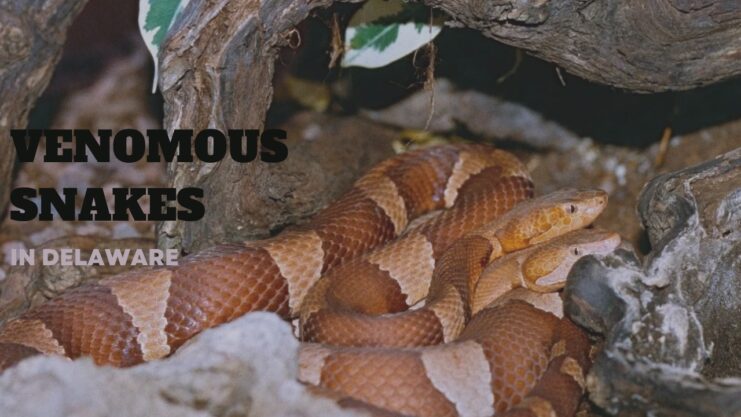Delaware, despite its small size, is home to a diverse array of snake species. Among the 19 species slithering around the First State, only one is venomous—the Eastern Copperhead.
While the tiny state may be small in size, it harbors a hidden gem in its reptilian realm. In this article, we turn our attention to the elusive and dangerous Eastern Copperhead, the sole venomous snake found within these borders. Join us as we delve into the fascinating world of this venomous serpent, uncovering its habitat preferences, behavioral traits, and venomous bite.
From the peaceful woodlands to the tranquil marshes, this state holds a secret that demands our attention. So, grab your magnifying glass and come along as we unravel the mysteries of the one venomous snake that calls Delaware home!
The Eastern Copperhead: Delaware’s Lone Venomous Snake

The Eastern Copperhead is a unique species that stands out among this state’s snake population. Its copper-colored head and cat-like vertical pupils make it easily identifiable. The snake is adorned with dark hourglass-shaped crossbands that are narrowest at the center of the back and wider at the belly, a feature exclusive to this species in Delaware.
Copperheads rely on their venom for both capturing prey and as a defense mechanism. Interestingly, a snake may choose not to use its venom on a defensive bite, leading to what is known as a “dry bite.” These dry bites account for about 25% of defensive bites.
While bites from copperheads are uncommon and death from a bite is extremely rare, the venom can cause severe tissue damage to the bite area. Therefore, anyone who suspects they were bitten by a copperhead should seek medical attention immediately.
Characteristics of the Eastern Copperhead
| Characteristic | Description |
|---|---|
| Color | Copper-colored head, dark hourglass-shaped crossbands |
| Length | Adult copperheads typically grow to between 2 and 3 feet long |
| Habitat | Found only in southern Sussex County and near Wilmington in Delaware |
| Venom | Hemotoxic venom is used for capturing prey and for defense |
| Bite | Can cause severe tissue damage, but death is extremely rare |
Other Snakes in Delaware
The state is home to several non-venomous snake species. Take a look at the table below to learn more about them:
| Species | Description | Diet | Habitat | Average Size |
|---|---|---|---|---|
| Eastern Rat Snake | Mostly black with a white area around the mouth and chin. Juveniles are gray or grayish-white with dark, rectangular blotches on their back. | Primarily feeds on warm-blooded prey such as mice, small birds, and bird eggs. | Found throughout Delaware, often in forests, fields, and farmlands. | Adult rat snakes can grow to about five feet long. |
| Black Racer | Jet black with a white chin. Hatchlings and yearlings are grayish with dark blotches on their backs, but they turn solid black in their second year. | Feeds on a variety of prey, including small mammals and birds, frogs, and even other snakes. | Widespread across Delaware, often found in open, sunny areas like fields, meadows, and farmlands. | Similar to rat snakes in size, they can grow to about five feet long. |
| Common Garter Snake | Greenish-brown, usually with a central yellow stripe flanked by a checkered pattern on the back. | Feeds primarily on frogs, fish, and garden slugs. | Associated with aquatic habitats, but they may also be found far from water. | Adults are about 2.5 feet long. |
| Common Watersnake | Brownish snake with dark crossbands across the back. These bands are widest along their backs and taper somewhat closer to the belly. | Feeds primarily on fish and frogs. | Usually found near water including ponds, streams, rivers, ditches, and other wetlands. | The common watersnake is about three feet long. |
How To Avoid Snakes—Top Tips
Snakes play a crucial role in maintaining the balance of our ecosystem. They help control rodent populations and serve as food for other wildlife.
While the presence of a venomous snake like the Eastern Copperhead may seem alarming, it’s important to remember that they are not typically aggressive unless threatened. By understanding their behavior and respecting their space, we can coexist peacefully with these fascinating creatures.
However, there are tips on how to avoid encountering a snake that you will find handy if you don’t want to find yourself in close vicinity of these creatures. Check out the list below to find these tips:
- Maintain a clean and well-kept lawn and yard by regularly cutting the grass short and preventing the growth of weeds in your flowerbeds.
- Ensure the branches of shrubs are trimmed to a height of one foot from the ground to remove potential hiding spots.
- Avoid the accumulation of leaves in piles near the foundation of your house, around the air conditioning unit, or beneath the deck.
- Keep wood piles tidy, elevated off the ground, and distanced from the house.
- Refrain from feeding pets outdoors or storing birdseed in a shed as it may attract rodents.
- Fill in any cracks and gaps found in and beneath concrete slabs and along your house’s foundation.
- Make sure the siding of your house is securely fastened along the lower edge.
For a more comprehensive understanding of venomous snakes, you might want to check out this resource, which provides an in-depth exploration of the species found in Florida.
Conclusion
As we conclude our exploration of Delaware’s venomous snake, we hope you have gained a deeper appreciation for the Eastern Copperhead’s role in the state’s biodiversity. Despite its potentially dangerous bite, this species plays a special role in maintaining ecological balance.
Remember, if you encounter an Eastern Copperhead in the wild, exercise caution and maintain a safe distance. By fostering respect and understanding, we can coexist with this remarkable creature and continue to enjoy the natural wonders that Delaware has to offer.
Related Posts:
- Celebrity-Owned Casinos: A Behind-The-Scenes Look at…
- The Glitz and Glamor of Casino Entertainment: An Inside Look
- Unveiling Venomous Snakes in Georgia: An Exciting…
- Finding the Best Camping Spots in Delaware Has Never…
- 5 Biggest Fish in Delaware - Enormous Aquatic Wonders
- 4 Most Venomous Snakes in Arizona - Stay Safe on…




















